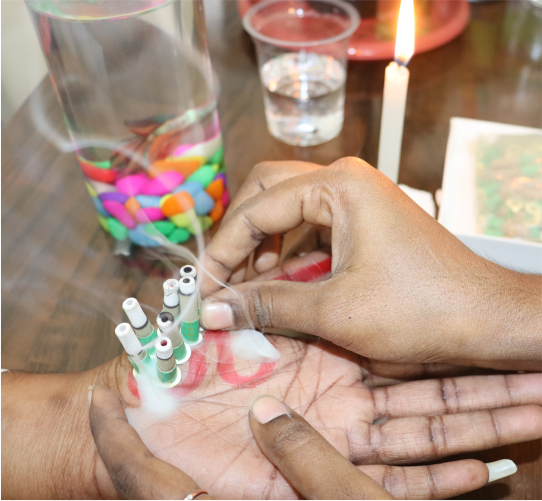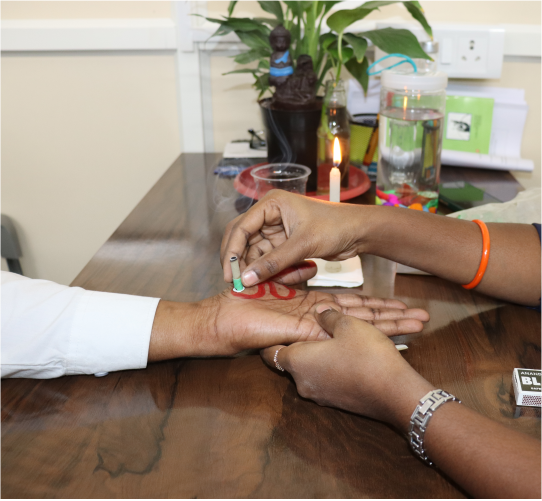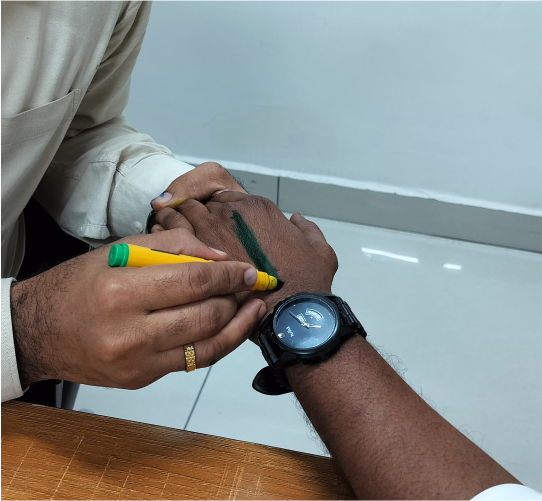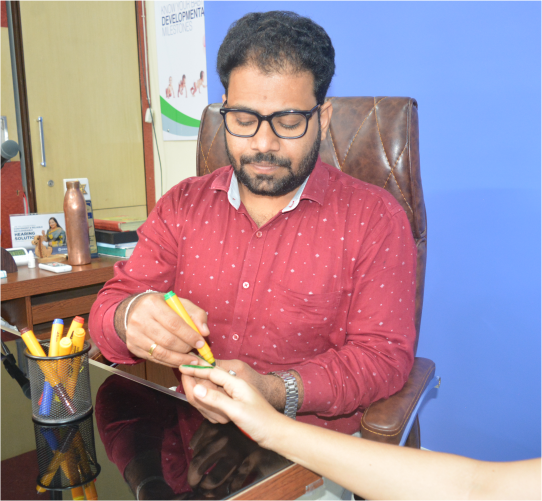Sujok Six Ki Therapy
“Balancing Energy, Healing Harmony: Embrace Wellness with Sujok Six Ki Therapy!”
Sujok Six Ki Therapy
Sujok Six Ki Therapy, also known as Su Jok 6 Ki or 6Ki Therapy, is a holistic healing system that is part of the broader field of Sujok Therapy. Sujok Therapy is based on the idea that the hands and feet are microcosms of the human body.
Ashoka’s Sujok Six Ki Therapy specialists adopt various therapeutic methods to stimulate specific points on the hands and feet corresponding to these Six Ki. These methods may include acupressure, massage, seed or magnet therapy, and other non-invasive techniques.
The goal of Sujok Six Ki Therapy is to balance the energy flow in the body, promote self-healing, and address various physical and emotional conditions. Our practitioners believe that by harmonizing the Six Ki energies, it is possible to restore balance to the corresponding organs and systems, leading to improved health and well-being.
Features
Ashok Rehab’s Sujok Six Ki Therapy encompasses several distinctive features that characterize its approach to healing. Here are key features of Sujok Six Ki Therapy:
Six Ki Energy Principles: Central to Sujok Six Ki Therapy is the concept of Six Ki, representing six fundamental energy principles associated with the five elements of traditional Chinese medicine (Wood, Fire, Earth, Metal, Water) and the additional element of Ether. Each of these Six Ki is believed to correspond to specific organs and systems in the body.
Hand and Foot Correspondence: Sujok Therapy, in general, posits that the hands and feet mirror the entire body. In Six Ki Therapy, specific points on the hands and feet are stimulated to influence the corresponding Six Ki energies and promote balance within the body.
Holistic Approach: Sujok Six Ki Therapy adopts a holistic perspective, recognizing the interconnectedness of the physical, mental, and emotional aspects of an individual. Imbalances in the entire system are addressed and not just the symptoms.
Non-Invasive Techniques: The focus is on acupressure, massage, and seed or magnet therapy. These techniques are very gentle and can be applied without the use of needles.
Individualized Treatment: Like many holistic healing modalities, Sujok Six Ki Therapy emphasizes individualized treatment. Practitioners consider the unique constitution and conditions of each person, tailoring the therapy to meet specific needs.
Energy Balancing: The primary goal of Sujok Six Ki Therapy is to balance the energy flow in the body. By addressing imbalances in the Six Ki energies, the therapy aims to enhance the body’s ability to heal itself and maintain overall well-being.
Integration with Traditional Chinese Medicine: Sujok Therapy draws on principles from traditional Chinese medicine, including the concept of meridians and energy channels. The therapy integrates these ideas into its approach to healing.
Complementary and Alternative Medicine (CAM): Sujok Six Ki Therapy is often considered a form of complementary and alternative medicine (CAM). It is used alongside conventional medical treatments and is not a replacement for professional medical care.
Self-Help Techniques: Sujok Therapy encourages individuals to learn and apply self-help techniques. This empowerment allows individuals to participate actively in their well-being and apply simple methods for self-care.
Focus on Prevention: Beyond addressing existing health concerns, Sujok Six Ki Therapy places emphasis on preventive measures. By maintaining balance and harmony in the body’s energy, individuals may reduce the risk of developing various health issues.
Ashok CDC considers Sujok Six Ki as a complementary therapy. So, parents should consult our trained and qualified healthcare professionals to ensure that the therapy aligns with their overall health plan and to receive guidance on its application.
Benefits
Ashok CDC’s Sujok Therapy offers a range of potential benefits for children, addressing various physical and emotional issues. While the effectiveness of Sujok Therapy may vary from person to person, here are some potential benefits for children:
Pain Relief: Sujok Therapy, particularly acupressure techniques, may help alleviate pain in children especially of headaches, stomach aches, and other types of discomforts.
Improved Sleep: The therapy’s relaxing effects may result in sleep patterns in children struggling with insomnia.
Enhanced Immunity: Sujok Therapy is thought to stimulate the body’s energy flow, which may contribute to a strengthened immune system. This can be beneficial in preventing common illnesses in children.
Emotional Well-Being: The holistic nature of Sujok Therapy helps to reduce stress, anxiety, and promote a sense of calm and balance.
Digestive Health: Acupressure points related to digestive organs are often targeted in Sujok Therapy.
Respiratory Health: Sujok Therapy techniques may be applied to address respiratory issues in children, including conditions like asthma and allergies.
Developmental Disorders: Sujok Therapy suggest has positive effects on children with developmental disorders, such as ADHD (Attention Deficit Hyperactivity Disorder) and autism.
Enhanced Concentration and Focus: By promoting relaxation and balancing energy, Sujok Therapy may contribute to improved concentration and focus in children, potentially benefiting their academic performance.
Complementary to Conventional Treatment: Sujok Therapy is often used as a complementary approach alongside conventional medical treatments. It can be integrated into a comprehensive healthcare plan for children.
Reduced Anxiety and Stress: Gentle techniques used in Sujok Therapy may help children cope with anxiety and stress, promoting a sense of relaxation and well-being.
Empowerment and Self-Care: Knowledge of Sujok techniques can help parents and care takers to actively participate in maintaining their health and well-being.
Better Sleep Quality: The therapy’s calming effects may contribute to improved sleep quality
It is suggested that, before using Sujok Therapy or any complementary approach for children, it’s advisable to consult our trained and qualified healthcare professionals. They can provide guidance on the appropriateness of such therapies for specific conditions and ensure that they complement, rather than replace, conventional medical care when needed.
Sujok Six Ki Therapy






Colour & Seed Therapy
Color therapy and seed therapy are practices within the realm of complementary and alternative medicine (CAM) that are occasionally employed to support child development. Color therapy, a form of energy medicine, utilizes different colors from the visible spectrum to encourage healing and well-being.
It operates on the premise that distinct colors possess unique energetic properties capable of influencing the mind and body. This therapy can manifest in various ways, such as wearing specific colors to enhance mood or using colored lighting to create a particular environment. Seed therapy, on the other hand, is a herbal medicine approach that harnesses the medicinal properties of plant seeds. It involves methods like consuming seeds for various health benefits, creating seed-infused water, or applying seeds topically for therapeutic effects.
Color and Seed Therapy Techniques:
Color therapy encompasses practices like wearing certain colors for mood enhancement, surrounding oneself with specific colors through environmental choices, and visualizing colors to induce a positive mental state. In seed therapy, techniques include incorporating seeds into the diet, preparing seed-infused water for consumption, and applying seeds to the skin for potential benefits. At Ashoka Rehab, we understand that while these therapies may sound promising, especially for child development, it is essential to approach them with caution due to the limited scientific evidence supporting their efficacy.
Safety Considerations and Consultation:
While some studies suggest potential benefits, it’s crucial to note that more research is needed to confirm the effectiveness of color and seed therapy for child development. Before exploring these CAM therapies, including color and seed therapy, it’s advisable to consult with a child’s doctor.
Safety considerations include potential side effects, such as dizziness or allergic reactions, associated with color and seed therapy. While generally considered safe, discontinuation is recommended if any adverse effects occur. In the pursuit of alternative approaches to child development, open communication with healthcare professionals ensures informed decision-making and safeguards the well-being of the child.
